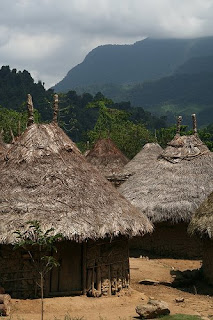La Ombligada -- Ties to the Future

There is a cultural tradition known as the “la ombligada ” that is performed on newborn Afro-Colombian children of the Pacific Coast. It is one of the oldest cultural traditions and is performed exclusively by midwives ( parteras ). The midwife’s role is to watch out for the well being of the infant and the mother before and after the birth. Once born, the midwife will tie ( ombligar ) the child to certain elements that are thought to then influence the child throughout his/her life. Let's say that the mother wants her child to be strong, or wealthy, or gifted in some way, then the midwife will tie certain elements to the child’s umbilical cord. For example, if a wealthy child is wanted, pieces of gold are placed on the umbilical cord and then tied on with cloth. If the mother wants a child that will be lucky in love, the beak of the tominé (a bird from the jungles of Chocó ) is used in place of the gold. Toenails of animals are also often used – those of an armadillo mean the ch










